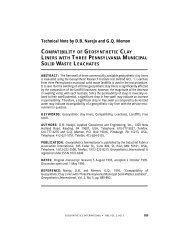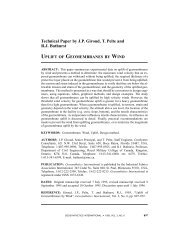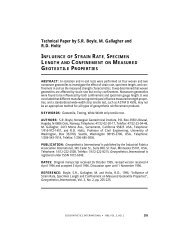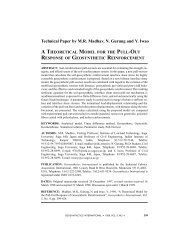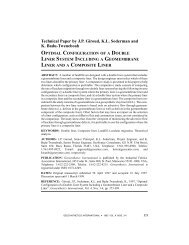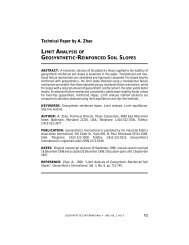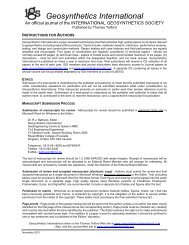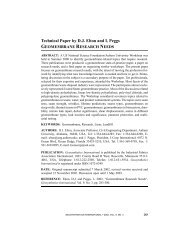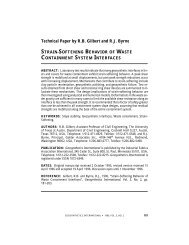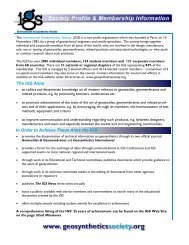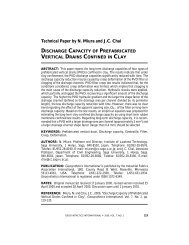Technical Paper by J.H. Greenwood - IGS - International ...
Technical Paper by J.H. Greenwood - IGS - International ...
Technical Paper by J.H. Greenwood - IGS - International ...
You also want an ePaper? Increase the reach of your titles
YUMPU automatically turns print PDFs into web optimized ePapers that Google loves.
GREENWOOD D Designing to Residual Strength Instead of Stress-Rupture<br />
where: a = crack length; A = a constant; n = index; and, K = stress concentration factor<br />
which is equal to σYa ½ for simple geometries, where σ = applied stress and Y =geometrical<br />
factor (Evans and Wiederhorn 1974). For any value of crack length, a, thereisa<br />
corresponding residual strength σ t with an initial value of σ 0 , corresponding to a critical<br />
value of K=K IC . By expressing σ t as a function of time and integrating, it can be shown<br />
that σ t is given <strong>by</strong> the following expression:<br />
σ n−2<br />
t<br />
= σ n−2<br />
0<br />
− σ n t B <br />
where B =2/((n - 2) AY 2 K n−2<br />
IC<br />
), omitting any effects of crack growth during tensile testing.<br />
The stress-rupture curve is given <strong>by</strong> setting σ = σ t which requires solving the following<br />
equation:<br />
(2)<br />
σ n−2<br />
t<br />
= σ n−2<br />
0<br />
− σ n t<br />
t B <br />
Since n is usually large and σ 0 > σ t , Equation 3 can be approximated using the following<br />
expression:<br />
σ n−2<br />
0<br />
= σ n t<br />
t B <br />
which plots as a double logarithmic stress-rupture diagram, and has a gradient of -(1/n).<br />
As mentioned above, for polyester the stress-rupture gradient is of the order of -1/40<br />
and thus n is equal to 40. Thus, if the values σ 0 =1,B =10 - 6 and n = 40 are substituted<br />
into Equation 2, then for an applied load of σ = 0.6 (i.e. 60% of tensile strength), the<br />
time to failure is 748 hours. After 720 hours, the residual strength is 91.7%, after 730<br />
hours it is 90.6%, and after 740 hours it is 88.7%, before reducing to 60% at failure.<br />
This example illustrates how a stress-rupture curve with a low gradient ( -1/n), as observed<br />
in geotextiles, may be associated with a high residual strength over most of the<br />
design life. This index implies that the majority of crack growth takes place just before<br />
failure, and thus the residual strength remains close to the original tensile strength. A<br />
complete model would have to incorporate the processes of primary and secondary<br />
creep, with decreasing and constant strain rates, respectively, as well as the chemical<br />
aspects of the fracture of polymer chains (Horrocks 1996).<br />
(3)<br />
(4)<br />
5 REVISED DESIGN PROCEDURE<br />
5.1 Residual Strength Due to Sustained Load Alone<br />
It is proposed that instead of using the stress-rupture curve directly, the design<br />
strength could be based on the residual strength curve, T R , corresponding to the anticipated<br />
design strength, T D .AvalueofT D must be found such that at the end of the design<br />
life, a factor of safety, f m , will remain between the design strength and the residual or<br />
available strength, T RD , such that T D =T RD /f m (Figure 5). In the absence of an analytical<br />
6 GEOSYNTHETICS INTERNATIONAL S 1997, VOL. 4, NO. 1



